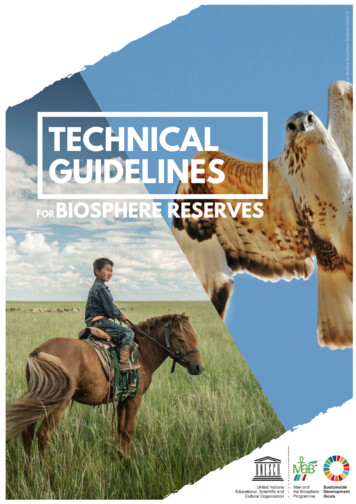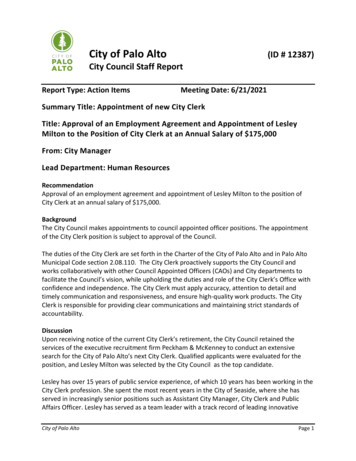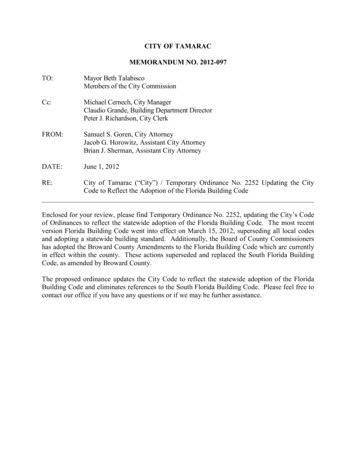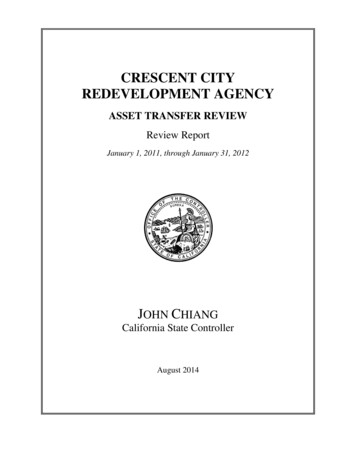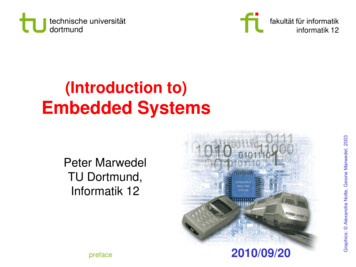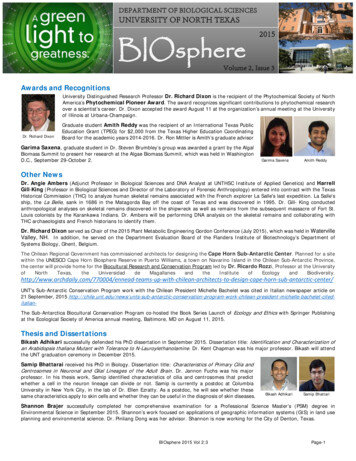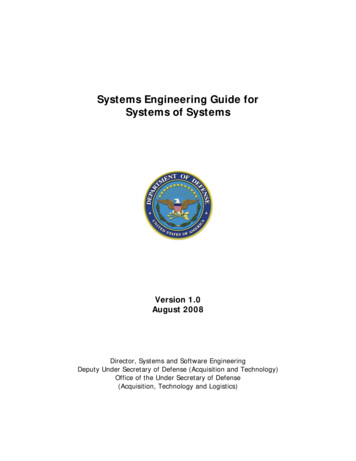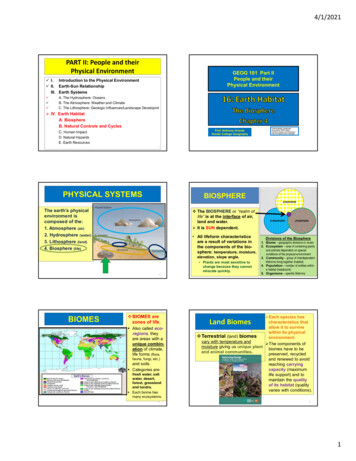
Transcription
4/1/2021PART II: People and theirPhysical EnvironmentGEOG 101 Part IIPeople and theirPhysical Environment I. Introduction to the Physical Environment II. Earth-Sun RelationshipIII. Earth Systems A. The Hydrosphere: OceansB. The Atmosphere: Weather and ClimateC. The Lithosphere: Geologic Influences/Landscape Developmt IV. Earth HabitatA. BiosphereB. Natural Controls and CyclesProf. Anthony GrandeHunter College GeographyC. Human ImpactD. Natural HazardsE. Earth ResourcesLecture design, content andpresentation AFG 032021Individual images and illustrationsmay be subject to prior copyright.1PHYSICAL SYSTEMSBIOSPHEREATMOSPHEREThe earth’s physicalenvironment iscomposed of the:1. Atmosphere (air)2. Hydrosphere (water)3. Lithosphere (land)4. Biosphere (life) The BIOSPHERE or “realm oflife” is at the interface of air,land and water. It is SUN dependent. All lifeform characteristicsare a result of variations inthe components of the biosphere: temperature, moisture,elevation, slope angle. Plants are most sensitive tochange because they cannotrelocate quickly.3BIOMES BIOMES arezones of life. Also called ecoregions, theyare areas with aunique combination of climate,life forms (flora,fauna, fungi, etc.)and soils. Categories are:fresh water, saltwater, desert,forest, grasslandand tundra. Each biome hasmany ecosystems.5HYDROSPHERELITHOSPHEREDivisions of the Biosphere1. Biome – geographic divisions or zones2. Ecosystem – area of containing plantsand animals dependent on specialconditions of the physical environment3. Community – group of interdependentlifeforms living together (habitat)4. Population – number of entities withina habitat (headcount)5. Organisms – specific lifeforms 4 Each species hascharacteristics thatallow it to survivewithin its physical Terrestrial (land) biomesenvironment.vary with temperature and The components ofmoisture giving us unique plant biomes have to beand animal communities.preserved, recycledand renewed to avoidreaching carryingcapacity (maximumlife support) and tomaintain the qualityof its habitat (qualityvaries with conditions).Land Biomes61
4/1/2021COLDDRYBiomeDistribution:Physical Influences Biomes vary withtemperature andmoisture giving usunique zones of life,each with a combination of plants, animals, insects, fungiand all other livingorganisms.This diagram isavailable on thehome page.This diagram isavailable on thehome page.HOTWETVegetation SequenceHOTDRYDecreasing moisture7Vegetation SequenceVERYCOLDandDRYMODERATETEMPERTURE THOTandDRYHOT andSEASONNALLYWETHOT andWET9Simplified World Map of AnimalsVERYCOLD DRYMODERATETEMP PRECIPHOT DRYHOT withWET & DRYSEASONSHOT 10WETBiome Modeling using GISBy in-putting data into a GIS, we can create a model based onchanging variables. The “What if ?” scenarios can be studied.A: Future Species Distribution StudyB: Marine Habitat Suitability StudyAnimals and landhabitat go handin-hand, as do fishwith water habitat.11122
4/1/2021Soil FormationClimax VegetationBIOMES: zones of life that develop in a uniquecombination of temperature, moisture, soil and sunlight.Precipitationreceived (rain and snow) Climax vegetation is the best species forthe existing conditions within the biome.Depth of soil varies with temp.and moisture. When conditions change, new species bettersuited for the conditions invade and a new sequenceof plant growth begins.Graph shows temperature precipitation ineach region. When it stabilizes, climax vegetation is againattained. When factors change, the sequence begins again.Nature is always reaction to stimuli.Soil formation depends on temperature and moistureworking on bedrock and organic material over time.1314NATURAL CONTROLS and CYCLESClimax Community Climax community is a term in ecology describeing the combination of lifeforms (flora/fauna/fungi)existing undisturbed at a particular location. The community developed over time in response to aset of physical conditions and has been stabilized. A change in any of the conditions will upset thedynamic, destabilize it and put change into motion. Examples of disruption include: global climatechange, deforestation, reservoir building, speciesextinction, wildfire, human interference in life cycles,as killing local predator animals. A. Temperature Controls: rotation (day and night),revolution (the seasons), cloud cover, and oceancirculation (surface, deep sea). B. Geologic Cycle: plate tectonics, rock cycle,building and gradational forces C. Biogeochemical Cycles1.2.3.Hydrologic (water) cycleCarbon-Oxygen cycleNutrient cycle*All these controls and cycles are interrelated.*1516HydrologicCycleBiogeochemical Cycleshttps://www.youtube.com/watch?v al-do-HGuIk6 min Water Cycle video1. Evaporation processremoves water molecules from oceans, lakes, land andbiota leaving behind salts and pollutants.2. Wind moves atmospheric moisture around the globe.3. Clouds are created at the condensation point.4. Precipitation occurs after saturation is reached; returnswater to the earth’s surface where it is collected and stored.5. Infiltration soaks it into the ground (percolation).6. Runoff is when water flows over the land.7. Water returns to the oceans, lakes, land and biota to beginthe cycle again when it is discharged.Biogeochemical cycles transfer matter betweenthe atmosphere, hydrosphere, and lithosphere.The cycles shown here are diagrammatic and therefore simplified.https://www.youtube.com/watch?v d70iDxBtnas 5 min carbon cycle17183
4/1/2021Carbon‐Oxygen CycleHydrologic CycleCarbon dioxide (CO₂) iscreated by respiration,decay and combustionwhich uses oxygen (O₂)in the process.34 precipitation4LAND1175 infiltration633 clouds7 collection6 runoff71 evaporation Photosynthesis: removesCO₂ and creates O₂.OCEANS Oceans play a great role in absorbing CO₂.88% of all evaporation is from the oceans.WATER ON LAND: 77% frozen; 22% underground; 1% surfaceof which only 0.6% is in lakes and rivers.Algae and marine life absorb it to create shells andeventually carbonate rocks. Human production of CO₂ is faster thanplants and the oceans can absorb it.1920Nitrogen CycleCarbon-Oxygen CycleNEGATIVE Variables of Human Impact1. Deforestation (decreases absorption of CO₂)2. Burning of fossil fuels (adds more CO₂)3. Urbanization (decreases absorption; adds more CO₂ )4. Pollution of the ocean surface (decreasesabsorption of CO₂)5. Global warming (melting of permafrost/ice packreleases stored CO₂ and other greenhouse gassestherefore adds more CO₂ to the atmosphere)21For nitrogen (N2) to be used, it has tobe converted into water-solublecompounds, esp. ammonia (NH3) and Nitrogen fixation: theprocess that makes nitrogenusable. It occurs two ways innature: (1) in the soil by the nitrogenfixing bacteria found on certainplant roots; and (2) in the air bylightning which converts atmospheric N2 (via an intense electrostatic discharge) into ammoniaand nitrate and returns it to earthwith rain or snow. Manufacturers convert nitrogen gas intoammonia, nitrates and nitrites and incorporate it into nitrogen-rich fertilizers usedby farmers to supplement the amount inthe soil.nitrate (NO3). Plants can absorb them Denitrification completes thewith water intake and use them to makecycle by converting nitrate (NO3)chlorophyll (needed for photosynthesis).back to a gas (N2).22Nutrient CycleNutrient CycleThe nutrient cycle adds fertility to thesoil. There are 3 aspects of the cycle:1. DECOMPOSITION: rotting organic material(mixes with inorganic material to give a balanced soil).2. FIRE: ash residue from burnt vegetation(ash and vaporized nutrients released into atmosphere mix with rainwater which is absorbed bythe soil. NOTE: ash is naturally alkaline and counteracts ahigher acidic pH levels in a soil.) Water and temperaturedependent.3. FLOODING: enriched sediment and water(seasonal flooding leaves behind a layer oforganic and inorganic nutrients taken fromupstream areas; supplements local nutrients). Too dry or too cold slowsthe process.23244
4/1/2021Benefits of a Forest FireNUTRIENT CYCLE: Human impact Nutrient release to soil, esp.when mixed with rainwater. Regrowth of remnant rootsand seeds Allows expansion of neighboring ecosystems (climaxvegetation sequence begins) Rapid restoration of energyflow and nutrient cycling(exposure to sunlight; thinneratmosphere/lithosphere inter- Also,face; better water absorption) Reduces chance of catastrophic fireThe nutrient cycle has been affected by: Land alternation: cutting forests, plowing grasslands, urbanization, suburbanization, roads Dousing forest/grassland fires Stream alteration: dam building, dredging, levees Land pollution: landfills, mining waste, toxic spills Misuse of artificial fertilizers/herbicides: affectorganisms in biosphere (soil); cause water pollution,eutrophication (oxygen depletion in water), adverseeffects on life forms (toxicity). Controls insect pests Controls plants diseases Adds to biodiversity (flora and fauna)2526NEXTNatural Hazardsand Human Impact275
Physical Environment Prof. Anthony Grande Hunter College Geography Lecture design, content and presentation AFG 032021 Individual images and illustrations may be subject to prior copyright. PHYSICAL SYSTEMS The earth's physical environment is composed of the: 1. Atmosphere(air) 2. Hydrosphere (water) 3. Lithosphere (land) 4. Biosphere (life .
